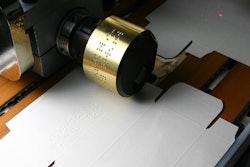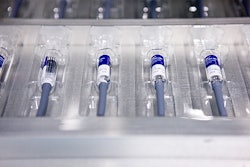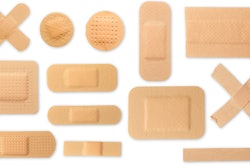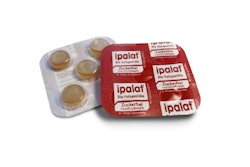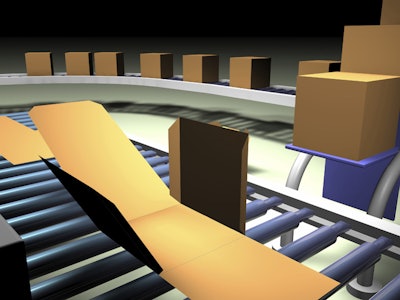
A company that develops and distributes medical implant devices, surgical instrumentation, and biologic services to hospitals and physicians throughout the United States proclaims on its Web site a commitment “to making every day a great day in the operating room for the surgeon, the operating staff and, above all, the patient.”
But it wouldn't be a “great day in the O.R.” for the doctors, staff, or for the patient, if a new knee joint, a replacement hip, a supply of bone cement, or any number of prescription drugs didn't make it to the hospital, were damaged or had expired.
More than 13 million prescription medicines and healthcare products are delivered to 144,000 pharmacies, hospitals, nursing homes, physician offices, clinics, government, and other providers every day. Before these medical products and components, many of them on a life-saving mission, make it into the hands of the medical staff or the patient, they must be shipped from the manufacturer to a hospital or pharmacy by way of a distribution center, or DC.
DCs may measure hundreds of thousands of square feet, and are often equipped with the latest in high-tech equipment and state-of-the-art computer software. This technology is designed to interact smoothly and efficiently with thousands of different products, sizes, and styles in a fast-paced, high-pressure environment where speed and accuracy rule the day.
The immediate challenge of ensuring the smooth and timely flow of product within the distribution center often starts with the daunting task of keeping track of the thousands of SKUs on hand as the healthcare industry continues to expand, with the number of products available on the market increasing. This challenge might seem no different than those associated with distributing any other finished good in a completely different industry, but healthcare products are under the scrutiny of the federal government and have a significantly higher liability exposure than most other goods.
Automating DCs
Therefore, when growth occurs for companies that distribute healthcare products, the switch to an accurate, efficient automated system is often done early. Additionally, automated distribution systems enable distributors of healthcare products to manage inventory in real time, process orders quicker for shipment, customize the auditing requirements prior to shipment, and also provide a host of reporting services. These reporting services are customizable so that distributors can make operational decisions that improve their customer's satisfaction level.
Switching to an automated system inside the DC typically means using multiple technologies such as A-frames, pick-to-light, pick-to-voice, vertical carousels, a Warehouse Control System, along with a discipline of frequent re-slotting of products to make sure the proper SKUs are stored and picked from the right systems. Utilizing these technologies also mandates the need to have many different storage mediums to properly handle all the SKUs on hand according to how quickly they move. For example, slower-moving products might be stored and picked from shelving, while faster-moving products might be stored and picked from carton flow or pallet flow rack with personnel being directed visually by lights at the pick face or by voice through a head set.
The advantage of the widely used A-frame technology is that it can also serve as a unitized sorter, automatically dispensing individual product into unique orders. It is advantageous for higher-velocity SKU's and provides accuracy. That's why one of TriFactor's customers, a leader in the ophthalmic industry, utilizes multiple A-frames to dispense small cartons of unchanging dimensions into totes running down the middle of the A-frames prior to final packaging, labeling, and shipping.
However, the downside is that it does require a relatively small, uniform product size that does not change often, and the system must be manually replenished. But many pharmaceutical companies still find that when working with various product sizes, order profiles, and SKU velocities, where a blend of speed and order accuracy are essential, that A-frame technology is often most effective.
Because of the type of products being handled, it's imperative that the proper storage medium be put in place, particularly when dealing with products that have shorter expiration dates and are often under strict FDA regulations. This is where FIFO (First In, First Out) plays an important role, as does ensuring the accuracy of returns. Therefore, utilizing carton flow rack coupled with either pick-to-light or pick-to-voice in the order-picking process assures that items are picked in the same order that they were stocked in a fast and accurate manner.
Finally, from a storage point of view, there are challenges when dealing with products that must stay frozen (such as bone tissue), goods that require special security measures (for example, certain prescription drugs) and those monitored by government agencies (such as the FDA), as well as areas that need to be equipped with humidity sensors, motion detectors, and audible alarms.
Healthcare's quality culture
When designing a material handling system for the healthcare industry, it also becomes quickly apparent that there is a unique mindset among management and workers that isn't often seen in other industries. Workers moving cases of pet food don't feel like they work in a pet store; workers handling cartons of rum don't feel like they work in a liquor store. There is, however, a “medical culture” in the healthcare distribution community that permeates the industry, from the skills and education of the worker to the environment they work in.
The healthcare industry appears to have a more narrowly focused and trained “industry-specific” workforce that tends to take their jobs seriously, because if they don't someone's life could be in jeopardy. The industry as a whole demands a high level of system accuracy and a healthier and cleaner work environment with less noise, which immediately sets it apart from more traditional warehouse and distribution center operations. These DCs often start the clean and quiet tone with the type of equipment they select.
Additionally, it is common in the healthcare industry for many companies to invest early in high technology distribution solutions not only to maximize efficiency, but also in the interest of creating a safe and ergonomically friendly work environment, where the DC is often as immaculate as the manufacturing facilities. A clean, quiet DC can often be used as a sales tool to show potential customers of healthcare product distributors the diligence that goes into packaging each shipment. The message conveyed to potential customers is clear: Product will be delivered on time, accurate, undamaged, and immaculate. That is what the end users demand.
Quiet, efficient, conveyor systems
Perhaps one of the major advancements in reaching these industry goals was the introduction of the 24V MDR (motorized drive roller) conveyor, which is not only 40% to 60% more energy-efficient, but also 45% quieter than traditional conveyor systems. Also, since this type of conveyor is driven off of low-voltage motors, the need for large, greasy, and loud A/C motors is eliminated.
TriFactor's first use of 24V MDR in the healthcare industry was in 2002 at a distributor of diabetic supplies. The system integrated both pharmacy and supply products into a unique automated order-fulfillment solution that runs quietly and efficiently. Since then, the company has grown dramatically and has expanded its operations from a local concentration to a more regional one.
When TriFactor installed a 24V MDR system for Exactech, a Gainesville FL-based manufacturer of medical implants and devices, Kevin Godwin, Exactech's director of customer operations, noted, “One of the major impacts of the new system was the positive effect it has had on our employees, who are now working in a fully functional warehouse environment with the noise level of a library.”
A conveyor system can be noise-free for one of two reasons: Because it's an efficient, environmentally friendly system, or because it's not running. That critical interruption is what needs to be avoided in an industry that can literally live and die on the need for speed, accuracy, and minimum downtime. This is where proper maintenance becomes paramount to keeping productivity at its peak.
Healthcare consolidation and growth
The healthcare industry demands a cleaner environment, not just for its employees but also for its equipment. A cleaner environment can be as simple as making sure ventilation filters are clean and conveyor rollers are kept in good working condition; but even this can create a challenge. Some medical product distributors have their conveyors on a carpeted floor as opposed to a traditional cement floor, which makes cleanup of oil and other materials more difficult. Equally important in maintaining a smooth operation is to make sure a system doesn't remain down because of a lack of spare parts, which should always be kept on hand in case of an emergency.
As consolidation in the healthcare industry increases, with large companies buying smaller ones and rolling products into a single distribution center, the need for more space and better inventory control becomes an increasingly important factor. For instance, if a company has a certain amount of storage/distribution capacity in its facilities when it acquires another company's products, it either has to increase storage/distribution capacity to account for the new products, or it has to become more efficient at how it handles its original products, since the same capacity now needs to accommodate and account for the new products.
The material handling industry must keep in step with the need for this ongoing growth and change. This can be as simple as configuring a system that is flexible enough to be manipulated with the ever-changing work environment, to literally “grow” as the company grows.
“When we went into a new building,” says Exactech's Godwin, “it was important for us not to have a rigid system in place. TriFactor gave us a system that was very flexible, that actually allowed us to move 10-foot sections of our conveyor around to fit our requirements, like the train tracks you used to play with as a kid. This flexibility allowed us to handle our growth rate without any negative impact to our customers.”
The material handling industry must realize that the healthcare industry has its share of special requirements that make it unique. Only by staying abreast of the latest technologies and regulations governing the healthcare industry will the industry be able to stay ahead of the curve on the latest innovations in inventory management and automation, which will ultimately result in more efficient distribution solutions.
--John T. Phelan, Jr., P.E., is Chief Operating Officer of TriFactor, LLC , a material handling systems integrator based in Lakeland, Fla. He can be contacted at 863-577-2243 or [email protected].
But it wouldn't be a “great day in the O.R.” for the doctors, staff, or for the patient, if a new knee joint, a replacement hip, a supply of bone cement, or any number of prescription drugs didn't make it to the hospital, were damaged or had expired.
More than 13 million prescription medicines and healthcare products are delivered to 144,000 pharmacies, hospitals, nursing homes, physician offices, clinics, government, and other providers every day. Before these medical products and components, many of them on a life-saving mission, make it into the hands of the medical staff or the patient, they must be shipped from the manufacturer to a hospital or pharmacy by way of a distribution center, or DC.
DCs may measure hundreds of thousands of square feet, and are often equipped with the latest in high-tech equipment and state-of-the-art computer software. This technology is designed to interact smoothly and efficiently with thousands of different products, sizes, and styles in a fast-paced, high-pressure environment where speed and accuracy rule the day.
The immediate challenge of ensuring the smooth and timely flow of product within the distribution center often starts with the daunting task of keeping track of the thousands of SKUs on hand as the healthcare industry continues to expand, with the number of products available on the market increasing. This challenge might seem no different than those associated with distributing any other finished good in a completely different industry, but healthcare products are under the scrutiny of the federal government and have a significantly higher liability exposure than most other goods.
Automating DCs
Therefore, when growth occurs for companies that distribute healthcare products, the switch to an accurate, efficient automated system is often done early. Additionally, automated distribution systems enable distributors of healthcare products to manage inventory in real time, process orders quicker for shipment, customize the auditing requirements prior to shipment, and also provide a host of reporting services. These reporting services are customizable so that distributors can make operational decisions that improve their customer's satisfaction level.
Switching to an automated system inside the DC typically means using multiple technologies such as A-frames, pick-to-light, pick-to-voice, vertical carousels, a Warehouse Control System, along with a discipline of frequent re-slotting of products to make sure the proper SKUs are stored and picked from the right systems. Utilizing these technologies also mandates the need to have many different storage mediums to properly handle all the SKUs on hand according to how quickly they move. For example, slower-moving products might be stored and picked from shelving, while faster-moving products might be stored and picked from carton flow or pallet flow rack with personnel being directed visually by lights at the pick face or by voice through a head set.
The advantage of the widely used A-frame technology is that it can also serve as a unitized sorter, automatically dispensing individual product into unique orders. It is advantageous for higher-velocity SKU's and provides accuracy. That's why one of TriFactor's customers, a leader in the ophthalmic industry, utilizes multiple A-frames to dispense small cartons of unchanging dimensions into totes running down the middle of the A-frames prior to final packaging, labeling, and shipping.
However, the downside is that it does require a relatively small, uniform product size that does not change often, and the system must be manually replenished. But many pharmaceutical companies still find that when working with various product sizes, order profiles, and SKU velocities, where a blend of speed and order accuracy are essential, that A-frame technology is often most effective.
Because of the type of products being handled, it's imperative that the proper storage medium be put in place, particularly when dealing with products that have shorter expiration dates and are often under strict FDA regulations. This is where FIFO (First In, First Out) plays an important role, as does ensuring the accuracy of returns. Therefore, utilizing carton flow rack coupled with either pick-to-light or pick-to-voice in the order-picking process assures that items are picked in the same order that they were stocked in a fast and accurate manner.
Finally, from a storage point of view, there are challenges when dealing with products that must stay frozen (such as bone tissue), goods that require special security measures (for example, certain prescription drugs) and those monitored by government agencies (such as the FDA), as well as areas that need to be equipped with humidity sensors, motion detectors, and audible alarms.
Healthcare's quality culture
When designing a material handling system for the healthcare industry, it also becomes quickly apparent that there is a unique mindset among management and workers that isn't often seen in other industries. Workers moving cases of pet food don't feel like they work in a pet store; workers handling cartons of rum don't feel like they work in a liquor store. There is, however, a “medical culture” in the healthcare distribution community that permeates the industry, from the skills and education of the worker to the environment they work in.
The healthcare industry appears to have a more narrowly focused and trained “industry-specific” workforce that tends to take their jobs seriously, because if they don't someone's life could be in jeopardy. The industry as a whole demands a high level of system accuracy and a healthier and cleaner work environment with less noise, which immediately sets it apart from more traditional warehouse and distribution center operations. These DCs often start the clean and quiet tone with the type of equipment they select.
Additionally, it is common in the healthcare industry for many companies to invest early in high technology distribution solutions not only to maximize efficiency, but also in the interest of creating a safe and ergonomically friendly work environment, where the DC is often as immaculate as the manufacturing facilities. A clean, quiet DC can often be used as a sales tool to show potential customers of healthcare product distributors the diligence that goes into packaging each shipment. The message conveyed to potential customers is clear: Product will be delivered on time, accurate, undamaged, and immaculate. That is what the end users demand.
Quiet, efficient, conveyor systems
Perhaps one of the major advancements in reaching these industry goals was the introduction of the 24V MDR (motorized drive roller) conveyor, which is not only 40% to 60% more energy-efficient, but also 45% quieter than traditional conveyor systems. Also, since this type of conveyor is driven off of low-voltage motors, the need for large, greasy, and loud A/C motors is eliminated.
TriFactor's first use of 24V MDR in the healthcare industry was in 2002 at a distributor of diabetic supplies. The system integrated both pharmacy and supply products into a unique automated order-fulfillment solution that runs quietly and efficiently. Since then, the company has grown dramatically and has expanded its operations from a local concentration to a more regional one.
When TriFactor installed a 24V MDR system for Exactech, a Gainesville FL-based manufacturer of medical implants and devices, Kevin Godwin, Exactech's director of customer operations, noted, “One of the major impacts of the new system was the positive effect it has had on our employees, who are now working in a fully functional warehouse environment with the noise level of a library.”
A conveyor system can be noise-free for one of two reasons: Because it's an efficient, environmentally friendly system, or because it's not running. That critical interruption is what needs to be avoided in an industry that can literally live and die on the need for speed, accuracy, and minimum downtime. This is where proper maintenance becomes paramount to keeping productivity at its peak.
Healthcare consolidation and growth
The healthcare industry demands a cleaner environment, not just for its employees but also for its equipment. A cleaner environment can be as simple as making sure ventilation filters are clean and conveyor rollers are kept in good working condition; but even this can create a challenge. Some medical product distributors have their conveyors on a carpeted floor as opposed to a traditional cement floor, which makes cleanup of oil and other materials more difficult. Equally important in maintaining a smooth operation is to make sure a system doesn't remain down because of a lack of spare parts, which should always be kept on hand in case of an emergency.
As consolidation in the healthcare industry increases, with large companies buying smaller ones and rolling products into a single distribution center, the need for more space and better inventory control becomes an increasingly important factor. For instance, if a company has a certain amount of storage/distribution capacity in its facilities when it acquires another company's products, it either has to increase storage/distribution capacity to account for the new products, or it has to become more efficient at how it handles its original products, since the same capacity now needs to accommodate and account for the new products.
The material handling industry must keep in step with the need for this ongoing growth and change. This can be as simple as configuring a system that is flexible enough to be manipulated with the ever-changing work environment, to literally “grow” as the company grows.
“When we went into a new building,” says Exactech's Godwin, “it was important for us not to have a rigid system in place. TriFactor gave us a system that was very flexible, that actually allowed us to move 10-foot sections of our conveyor around to fit our requirements, like the train tracks you used to play with as a kid. This flexibility allowed us to handle our growth rate without any negative impact to our customers.”
The material handling industry must realize that the healthcare industry has its share of special requirements that make it unique. Only by staying abreast of the latest technologies and regulations governing the healthcare industry will the industry be able to stay ahead of the curve on the latest innovations in inventory management and automation, which will ultimately result in more efficient distribution solutions.
--John T. Phelan, Jr., P.E., is Chief Operating Officer of TriFactor, LLC , a material handling systems integrator based in Lakeland, Fla. He can be contacted at 863-577-2243 or [email protected].


